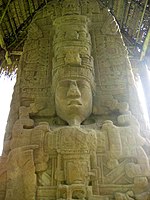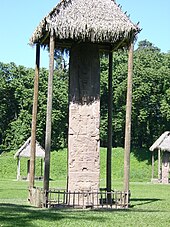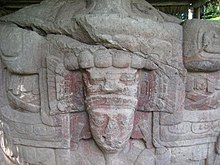Kʼakʼ Tiliw Chan Yopaat
| Kʼakʼ Tiliw Chan Yopaat | |
|---|---|
| Ajaw | |
 Stela D, north side, from Quiriguá, representing king Kʼakʼ Tiliw Chan Yopaat.[1] | |
| King of Quiriguá | |
| Reign | 29 December 724 - 27 July 785 |
| Predecessor | Unknown (Last known ruler: K'awiil Yopaat) |
| Successor | Sky Xul |
| Born | c.690[2] Quiriguá |
| Died | 31 July 785 (aged 94–95) Quiriguá |
| Issue | Sky Xul (possibly) |
| Religion | Maya religion |
Kʼakʼ Tiliw Chan Yopaat,[pronunciation?] previously known variously as Cauac Sky,[3] Kawak Sky, Butsʼ Tiliw[pronunciation?] and Butzʼ Tiʼliw, was the leader of the ancient Maya city-state of Quiriguá.
Reign
[edit]Kʼakʼ Tiliw Chan Yopaat ruled the city from 724 to 785 AD. The most significant event of his reign—and of Quiriguá's history—occurred in AD 738 (9.15.6.14.6 on the Mayan calendar), when his forces defeated the city of Copán. The ruler of Copán, Uaxaclajuun Ubʼaah Kʼawiil (formerly known as "18 Rabbit") was captured and later beheaded.[4] It began when, In 734, on Altar M at Quirigua, Kʼak Tiliw Chan Yopaat gives himself the title kʼuhul ajaw, thus declaring Quirigua's independence from Copan.[5] To formally declare his sovereignty, he received the K'awiil sceptre to signify his accession.[6][7][8]
Before Kʼakʼ Tiliw Chan Yopaat's bold move, Quiriguá had been a vassal of Copán.[9] The defeat of Copán led to its decline but heralded a golden age for its former dependent. For the next 38 years, stonecutters of Quiriguá created zoomorphs and stele celebrating their legendary king.

His monuments are significant as they refuted the European misconception that Indigenous populations were less advanced, showcasing their ability to create monumental and highly sophisticated civilizations. The tallest stele in the Maya world is stele E from Quiriguá, stretching 35 feet (10.7 metres high).[11] His monumental achievements, including the towering stele E carved from a single stone, echo the grandeur and symbolic power of Egyptian obelisks.[12]
Quiriguá became a fully autonomous city which controlled the main trade route from the Caribbean to the Maya world. Meanwhile, this incident was followed by a 20-year hiatus in inscriptions at Copán, as well as the disappearance of any further mention of 18 Rabbit.
Characteristics
[edit]
Kʼakʼ Tiliw Chan Yopaat, the ruler of Quirigua, has unique characteristics due to the remarkable similarities between his representations and Egyptian iconography.[13] His portrayal on monuments, such as stele E and stele C, or the face emerging from a turtle shell on Zoomorph B, features a distinctive long goatee beard reminiscent of Egyptian pharaohs.[12] Zoomorph B is believed to symbolize the water throne stone, one of the three hearth stones of creation associated with the Orion Constellation.[14] The Maya creation myth at Quiriguá describes the birth of the "First Father" from a turtle shell, as depicted on Zoomorph B, shortly after the three creation stones were tied. This event is marked in the long count calendar as 13.0.0.0.0, corresponding to August 11, 3114 BCE.[15][16] Additionally, Kʼakʼ Tiliw Chan Yopaat wore a unique double crown, paralleling the Pschent crown of Egypt's first pharaoh, Menes, symbolizing unification and divine rule of upper Egypt and lower Egypt.[12] These features, combined with his long reign and the celestial alignment of his monuments reflecting Orion's Belt, evoke the pharaonic tradition.[17]
Death
[edit]Current evidence leads to the conclusion that Kʼakʼ Tiliw Chan Yopaat died in 785 AD. There remains a stone at Quiriguá, now identified as Zoomorph G, which seems to have served as his funeral marker.[18]
Succession
[edit]Two other rulers are known to have reigned at Quiriguá in ensuing years—Sky Xul and Jade Sky—each for about ten years.[19]
Notes
[edit]- ^ Looper 2003, pp.122, 140, 146.
- ^ Looper 2003, p.234.
- ^ Cauac meaning "rainstorm".
- ^ Looper 2003, p.76.
- ^ Sharer 2006.
- ^ Riese 1986.
- ^ Le Fort 1994:19
- ^ Wright, M. A. (2011). A Study of Classic Maya Rulership (Doctoral dissertation, University of California, Riverside). https://escholarship.org/content/qt6pb5g8h2/qt6pb5g8h2_noSplash_acc079cd1ba843db7f2864c60cbcdf73.pdf
- ^ Looper 2003, p.79.
- ^ Cite error: The named reference
Coe121was invoked but never defined (see the help page). - ^ "Quiriguá, Guatemala (1839-1840)". www.sfu.ca. Retrieved 2024-12-29.
- ^ a b c Heyworth, Robin (2014-07-08). "Is This the Face of the Pharoah of Quirigua?". Uncovered History. Retrieved 2024-12-29.
- ^ "Quiriguá". Uncovered History. Retrieved 2024-12-29.
- ^ "Quirigua". mayan ruins website. Retrieved 2024-12-29.
- ^ "Mayan culture – The hearth stones of Creation – The Book of Threes". 2008-12-10. Retrieved 2024-12-29.
- ^ "Maya Calendar Converter | Living Maya Time". maya.nmai.si.edu. Retrieved 2024-12-30.
- ^ The Orion Mystery: Unlocking the Secrets of the Pyramids – Robert Bauval & Adrian Gilbert – Broadway Books (Aug 1995) – ISBN 978-0517884546
- ^ Martin & Grube 2000, p.222.
- ^ Martin & Grube 2000, p. 218.
References
[edit]- Drew, David (1999). The Lost Chronicles of the Maya Kings. London: Weidenfeld & Nicolson. ISBN 0-297-81699-3. OCLC 43401096.
- Looper, Matthew G. (1999). "New Perspectives on the Late Classic Political History of Quirigua, Guatemala". Ancient Mesoamerica. 10 (2). Cambridge University Press: 263–280. doi:10.1017/s0956536199101135.
- Looper, Matthew G. (2003). Lightning Warrior: Maya Art and Kingship at Quirigua. Austin, TX: University of Texas Press. ISBN 0-292-70556-5. OCLC 52208614.
- Velásquez García, Erik (2006). "Iconografía real de Kʼahkʼ Tiliw Chan Yoʼaat: política y fundación del mundo en Quiriguá, Guatemala". In Cuauhtémoc Medina (ed.). La imagen política: XXV Coloquio Internacional de Historia del Arte "Francisco de la Maza" [2001, San Luis Potosí, México]. Estudios de arte y estética, no. 60 (in Spanish). México, D.F.: Instituto de Investigaciones Estéticas-Universidad Nacional Autónoma de México. pp. 113–146. ISBN 978-970-32-1883-7. OCLC 219717969.
- Martin, Simon; Nikolai Grube (2000). Chronicle of the Maya Kings and Queens: Deciphering the Dynasties of the Ancient Maya. London and New York: Thames & Hudson. ISBN 0-500-05103-8. OCLC 47358325.
- Webster, David L. (2002). The Fall of the Ancient Maya: Solving the Mystery of the Maya Collapse. London: Thames & Hudson. ISBN 0-500-05113-5. OCLC 48753878.

